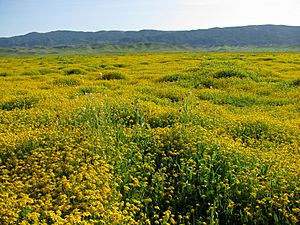Cupped monolopia facts for kids
Monolopia major is a beautiful flowering plant often called the cupped monolopia. It belongs to the aster family, which also includes sunflowers and daisies! This plant is special because it only grows in certain parts of California.
Quick facts for kids Cupped monolopia |
|
|---|---|
| Scientific classification | |
| Kingdom: | |
| (unranked): | |
| (unranked): | |
| (unranked): | |
| Order: | |
| Family: | |
| Genus: | |
| Species: |
M. major
|
| Binomial name | |
| Monolopia major |
|
Contents
Where It Grows
Monolopia major is a plant that lives only in Central California. You can find it in the Inner North Coast Ranges and Inner South Coast Ranges.
Spotting the Difference
This plant looks a lot like another species called Monolopia lanceolata. But there's a trick to tell them apart!
- M. major has special leaf-like parts under its flower head called phyllaries that are joined together, forming a cup. This is easiest to see after the plant has finished flowering.
- M. lanceolata has phyllaries that are separate. Even if they look stuck together because of fuzzy hairs, you can gently pull them apart.
Another clue is the color of their flowers. M. major has bright, pure yellow flowers. M. lanceolata often has lighter yellow flowers that might look faded at the tips.
Soil and Climate
M. major is quite picky about where it grows. It loves clay soils, especially a type called vertic clay. M. lanceolata, on the other hand, can grow in many different soil types, from sandy to clay.
M. major also needs a good amount of rain, usually more than 11 inches per year. This means it often grows in areas like chaparral or blue oak woodlands. M. lanceolata can grow in these wetter places too, but it can also survive in drier spots with as little as 6 inches of rain per year.
Many large groups of M. major plants are found around San Benito Mountain in southern San Benito County.
What It Looks Like
Monolopia major is an annual plant, meaning it grows from a seed, flowers, produces seeds, and dies all within one year. It has a thin stem that can sometimes branch out. It can grow up to about 80 centimeters (about 31 inches) tall. The plant usually feels a bit fuzzy or "woolly."
Flower Heads
At the end of the stems, you'll find small, roundish flower heads. These heads are made up of many tiny flowers grouped together. The phyllaries (those leaf-like parts we talked about) are joined together, forming a cup shape around the base of the flower head.
The flowers themselves are golden, yellow, or cream-colored. The outer petals, called ray florets, can be up to 2 centimeters (about 0.8 inches) long. Each ray floret has three small lobes or tips. In the center of the flower head, there are many tiny disc florets.
Seeds
After the flowers bloom, the plant produces small fruits called achenes. These are like tiny seeds, about 2 to 4 millimeters (about 0.08 to 0.16 inches) long.


